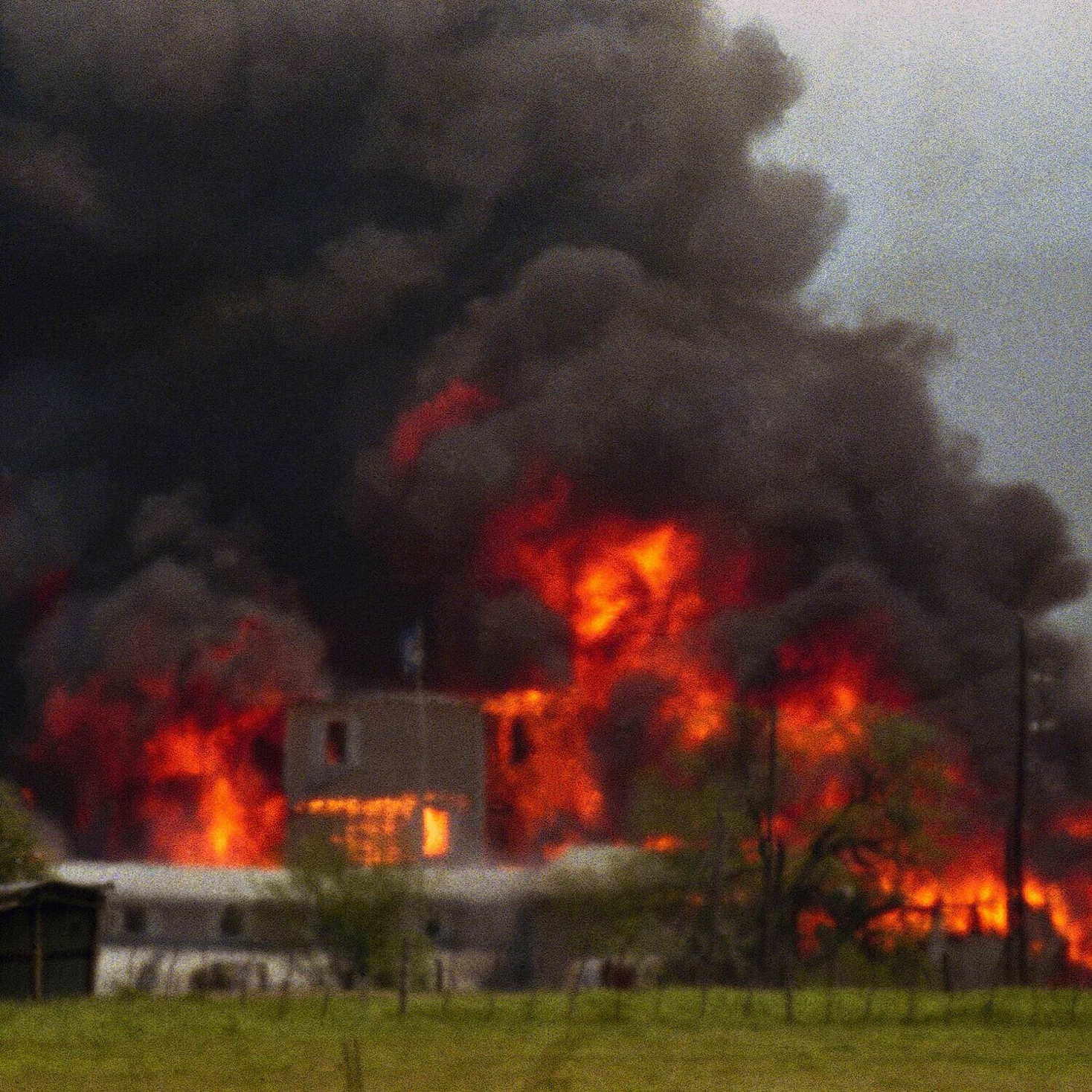Young Americans today learn of the 1993 standoff through pop culture and social media, often with an anti-government undertone
The TikToks start with a drive through the flat plains of Central Texas to the memorial site, the ethereal background music and praying-hands emoji evoking a pilgrimage.
Next up are plaques listing names of the dead, followed by a peek inside a makeshift museum with poster-size scenes of carnage on the walls. Moving back outside, the cameras linger on a square pit labeled “Vault where the mothers and children were gassed.” There’s often a testimonial at this point about how creepy the place is, how it’s hard to shake an eerie feeling.
“This is the site where the massacre was televised across the world,” a woman narrated in one recent post.
Roughly half the U.S. population is too young to remember the government’s fiery, ill-fated raid of a heavily armed religious sect outside Waco in 1993. And yet the infamous standoff has continued to captivate new generations, their understanding of what happened shaped by pop culture and politics, along with a flurry of new film and book versions timed to the 30th anniversary this month.
Waco still resonates three decades later partly because of the enduring horror — 86 dead, including more than 20 children — and partly, extremism analysts say, because the events are easily exploitable in today’s polarized, gun-saturated cultural landscape. The introduction to the siege might come through mainstream retellings by Netflix or Showtime, but follow-up online searches quickly lead to anti-government forums that draw a through line from Waco to what are presented as federal excesses in the prosecution of rioters who attacked the U.S. Capitol on Jan. 6, 2021.
“It still shows up as the go-to example for what they need to be prepared for, to fight against,” said Casey Cox, a political scientist at Texas A&M University who studies domestic terrorism. “If you’re somebody who maybe watched the documentary and then decide to look up more about it, it would be very easy to fall down some dark rabbit holes.”
The conflict began Feb. 28, 1993, when agents from what is now known as the Bureau of Alcohol, Tobacco, Firearms, and Explosives (ATF) carried out a raid based on information that the Branch Davidians fringe group was stockpiling illegal weapons at a compound outside Waco. The sect’s leader and messiah figure, David Koresh, was tipped off about the operation and a gun battle erupted when the authorities arrived, resulting in the deaths of four agents and six members of the group. Many others were wounded on both sides.
News outlets around the world converged on Waco as the raid turned into a weeks-long standoff that ended on April 19, 1993, when federal agents launched a tear-gas attack to force out the Branch Davidians. Few emerged. Within hours, the compound was engulfed in flames — the origin of the fire remains in dispute — and viewers watched on live TV as it burned to the ground. By the end of the ordeal, more than 70 people inside were dead, including roughly two dozen children and the leader, Koresh.
The scores of dead civilians outraged the nation and inspired violent anti-government reprisals, most notably the Oklahoma City bombing that killed 168 people on the second anniversary of the end of the Waco siege. The events of that spring are used by far-right recruiters to show skeptics why they should be prepared to battle federal authorities seen as infringing on constitutional rights.
“Waco is significant because it is used as the alibi for domestic terrorism: because the federal government killed Branch Davidians at Waco, the story goes, violence against the federal government (and collateral damage against civilians) can be justified,” Kathleen Belew, a Northwestern University professor who studies white-power movements, tweeted last month in a thread about the siege.
Extremists still hold up Waco as Exhibit A of a “tyrannical government” that seeks to disarm citizens in violation of the Second Amendment, an idea that has moved from the fringes to the mainstream in the hard-right shift of conservatism in recent years. Many political analysts view it as no coincidence that Donald Trump, the leading Republican presidential candidate, chose Waco last month as the first stop for his 2024 campaign.
“Either the deep state destroys America or we destroy the deep state,” Trump told the rally.
Trump’s appearance was “a clear signal to his antigovernment worshipers,” wrote Jeff Guinn, a former investigative journalist whose latest book, “Waco: David Koresh, the Branch Davidians, and A Legacy of Rage,” was released in January.
Google Trends shows that siege-related searches soared around the time of Trump’s March 25 rally and have remained higher than usual, likely boosted by the uptick in interest around the 30th anniversary and buzz about both the recent Netflix documentary series, “Waco: American Apocalypse,” and Showtime’s five-part drama series, “Waco: The Aftermath,” released Sunday.
For years, Waco has been repackaged to reach Americans who came of age after the siege, often through a pop-culture lens that celebrates the Branch Davidians’ defiance against the government and glosses over allegations of sexual and other abuse from former members of the group and investigators.
Rappers and rock bands have dropped Waco references over the decades, among them Eminem, Nas, the Beastie Boys, Pitbull and Korn. In 1993, with news of the raid still fresh, Wu-Tang Clan’s Ghostface Killah rapped that he was “Dangerous, I blow sparks like Waco, Texas.”
The siege has cropped up as a scenario in numerous video games, including one with a disclaimer stating, “Please note: The above description of the Waco Siege is an extremely, extremely simplified version of a still discussed and highly disputed event.”
The most popular and interesting stories of the day to keep you in the know. In your inbox, every day.
The Chrononauts card game offers players the chance to travel back in time to 1993 and change history; the available outcomes are “Compound Burns to Ground” or “Standoff Defused Peacefully.” Online vendors hawk Waco-themed comic books, sweatpants, bumper stickers and other memorabilia.
Language around the siege has been turned into slang and puns, with “Waco” used as a stand-in for any volatile situation, or as an abbreviation for “We Ain’t Coming Out.” Urban Dictionary lists “Koresh” as a synonym for burned, giving the usage example “I koreshed the toast.” And at the height of protests against mask mandates, some right-wing picketers labeled their opponents “Branch Covidians.”
Other references are much darker, such as T-shirts lionizing Koresh, who sexually abused girls and women, according to investigators and survivor accounts. True-crime and conspiracy-theory podcasts regularly revisit the story of the siege in macabre detail, an old story finding new interest in an era of paranoia and skepticism about state institutions.
“Waco is one of those moments that, with a little bit of massaging, gets right into that narrative of federal tyranny,” said Sam Jackson, an extremism scholar whose book, “Oath Keepers,” discusses how Waco fueled the anti-government militia movement.
Every year, Canadian extremism scholar Amarnath Amarasingam teaches the Waco siege as part of his “Religion and Violence” course at Queen’s University in Ontario. And every year, he said, two aspects are the most debated among students: the “ATF overreach” and the “New Light doctrine,” Koresh’s belief that, as the messiah, he was the perfect mate for all his female followers, including underage girls he unofficially “married” and impregnated, according to the Justice Department.
“That’s where things get a little iffy for them,” Amarasingam said of his students’ debates. “What is the role of the state when child abuse is suspected and when does that precipitate a law enforcement response?”
Outside of class, Amarasingam said, there’s little room for nuance in the highly politicized public discourse around Waco.
“Like with anything else these days, it’s introduced through this ahistorical signposting phenomenon,” he said. “They pick and choose what’s relevant and they couldn’t tell you more than the meme-ified version of these historical incidents and events, whether that’s Ruby Ridge or Waco or Oklahoma City or even 9/11.”
The rise in Waco-related anti-government messaging aimed at young people is a phenomenon Kesa White studies as program manager of an extremism research lab at American University. She said the content ranges from humorous memes with “King of the Hill” characters to TikToks showing young men in tactical gear acting as if they’re shooting from a bedroom window, pantomiming the indelible moment of the siege when an ATF agent was struck on a rooftop.
Stripped of context and displayed like a video game, the bloodshed is diminished.
“They’re pretending that they’re shooting this agent,” White said. “I’m not sure if they comprehend and have that grasp that you’re not just being like a Civil War reenactor. This is something that’s more serious.”
ATF Deputy Director Marvin Richardson, the bureau’s second-in-command, is a native Texan who was at the siege as a young agent three decades ago. In a phone interview this week, Richardson said the years have flown by but haven’t dulled the pain of losing four colleagues on that first day of the raid.
He paused to name them: “Conway LeBleu, Steve Willis, Todd McKeehan, and Rob Williams.”
“We were pretty young guys back in the day but very much dedicated law enforcement professionals who were actually doing a job that day, serving a lawful order of the court,” Richardson said.
Richardson said he hasn’t seen the film or TV adaptations of the siege — “I’m not much of a television watcher” — and he said it was out of his purview to address the ways anti-government movements continue to exploit the standoff today on social media.
For ATF, Richardson said, the legacy is that “we have become better at a very, very high cost.” After Waco, he said, the bureau improved oversight and rewrote policies to prevent future deadly escalations. That’s what Richardson focuses on when young agents approach him at graduation ceremonies to hear stories about the siege.
“There’s a saying, ‘If you don’t know your history, you’re doomed to repeat it,’ and for us we want to make sure that never happens,” Richardson said. “So we embed that into the fabric of our agents in the academy, so that they understand what happened that day, just exactly how we have moved forward from those times. How we have learned from the most difficult lessons.”
Hannah Allam covers extremism and domestic terrorism as part of the National Security team.




